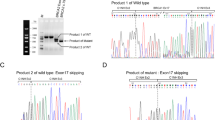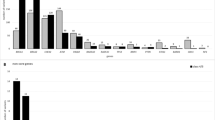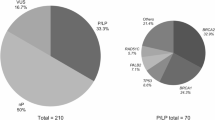Abstract
Interpretation of variants of unknown significance (VUS) is a major challenge for laboratories performing molecular diagnosis of hereditary breast and ovarian cancer (HBOC), especially considering that many genes are now known to be involved in this syndrome. One important way these VUS can have a functional impact is through their effects on RNA splicing. Here we present a custom RNA-Seq assay plus bioinformatics and biostatistics pipeline to analyse specifically alternative and abnormal splicing junctions in 11 targeted HBOC genes. Our pipeline identified 14 new alternative splices in BRCA1 and BRCA2 in addition to detecting the majority of known alternative spliced transcripts therein. We provide here the first global splicing pattern analysis for the other nine genes, which will enable a comprehensive interpretation of splicing defects caused by VUS in HBOC. Previously known splicing alterations were consistently detected, occasionally with a more complex splicing pattern than expected. We also found that splicing in the 11 genes is similar in blood and breast tissue, supporting the utility and simplicity of blood splicing assays. Our pipeline is ready to be integrated into standard molecular diagnosis for HBOC, but it could equally be adapted for an integrative analysis of any multigene disorder.
Similar content being viewed by others
Log in or create a free account to read this content
Gain free access to this article, as well as selected content from this journal and more on nature.com
or
References
Miki Y, Swensen J, Shattuck-Eidens D et al: A strong candidate for the breast and ovarian cancer susceptibility gene BRCA1. Science 1994; 266: 66–71.
Wooster R, Bignell G, Lancaster J et al: Identification of the breast cancer susceptibility gene BRCA2. Nature 1995; 378: 789–792.
Walsh T, Casadei S, Coats KH et al: Spectrum of mutations in BRCA1, BRCA2, CHEK2, and TP53 in families at high risk of breast cancer. JAMA 2006; 295: 1379–1388.
Bubien V, Bonnet F, Brouste V et al: High cumulative risks of cancer in patients with PTEN hamartoma tumour syndrome. J Med Genet 2013; 50: 255–263.
Hearle N, Schumacher V, Menko FH et al: Frequency and Spectrum of Cancers in the Peutz-Jeghers Syndrome. Clin Cancer Res 2006; 12: 3209–3215.
Pharoah PDP, Guilford P, Caldas C : Incidence of gastric cancer and breast cancer in CDH1 (E-cadherin) mutation carriers from hereditary diffuse gastric cancer families. Gastroenterology 2001; 121: 1348–1353.
Loveday C, Turnbull C, Ruark E et al: Germline RAD51C mutations confer susceptibility to ovarian cancer. Nat Genet 2012; 44: 475–476.
Rafnar T, Gudbjartsson DF, Sulem P et al: Mutations in BRIP1 confer high risk of ovarian cancer. Nat Genet 2011; 43: 1104–1107.
Southey MC, Goldgar DE, Winqvist R et al: PALB2, CHEK2 and ATM rare variants and cancer risk: data from COGS. J Med Genet 2016; 53: 800–811.
Ratajska M, Antoszewska E, Piskorz A et al: Cancer predisposing BARD1 mutations in breast-ovarian cancer families. Breast Cancer Res Treat 2012; 131: 89–97.
Golmard L, Caux-Moncoutier V, Davy G et al: Germline mutation in the RAD51B gene confers predisposition to breast cancer. BMC Cancer 2013; 13: 484.
Loveday C, Turnbull C, Ramsay E et al: Germline mutations in RAD51D confer susceptibility to ovarian cancer. Nat Genet 2011; 43: 879–882.
Hilbers FS, Wijnen JT, Hoogerbrugge N et al: Rare variants in XRCC2 as breast cancer susceptibility alleles. J Med Genet 2012; 49: 618–620.
Park DJ, Lesueur F, Nguyen-Dumont T et al: Rare mutations in XRCC2 increase the risk of breast cancer. Am J Hum Genet 2012; 90: 734–739.
Castéra L, Krieger S, Rousselin A et al: Next-generation sequencing for the diagnosis of hereditary breast and ovarian cancer using genomic capture targeting multiple candidate genes. Eur J Hum Genet 2014; 22: 1305–1313.
Gaildrat P, Krieger S, Di Giacomo D et al: Multiple sequence variants of BRCA2 exon 7 alter splicing regulation. J Med Genet 2012; 49: 609–617.
Cartegni L, Chew SL, Krainer AR : Listening to silence and understanding nonsense: exonic mutations that affect splicing. Nat Rev Genet 2002; 3: 285–298.
Sterne-Weiler T, Howard J, Mort M, Cooper DN, Sanford JR : Loss of exon identity is a common mechanism of human inherited disease. Genome Res 2011; 21: 1563–1571.
Venables JP : Aberrant and alternative splicing in cancer. Cancer Res 2004; 64: 7647–7654.
Soukarieh O, Gaildrat P, Hamieh M et al: Exonic splicing mutations are more prevalent than currently estimated and can be predicted by using in silico tools. PLoS Genet 2016; 12: e1005756.
Chen J, Weiss WA : Alternative splicing in cancer: implications for biology and therapy. Oncogene 2015; 34: 1–14.
Oltean S, Bates DO : Hallmarks of alternative splicing in cancer. Oncogene 2014; 33: 5311–5318.
Bonnet C, Krieger S, Vezain M et al: Screening BRCA1 and BRCA2 unclassified variants for splicing mutations using reverse transcription PCR on patient RNA and an ex vivo assay based on a splicing reporter minigene. J Med Genet 2008; 45: 438–446.
Houdayer C, Caux-Moncoutier V, Krieger S et al: Guidelines for splicing analysis in molecular diagnosis derived from a set of 327 combined in silico/in vitro studies on BRCA1 and BRCA2 variants. Hum Mutat 2012; 33: 1228–1238.
Colombo M, Blok MJ, Whiley P et al: Comprehensive annotation of splice junctions supports pervasive alternative splicing at the BRCA1 locus: a report from the ENIGMA consortium. Hum Mol Genet 2014; 23: 3666–3680.
Fackenthal JD, Yoshimatsu T, Zhang B et al: Naturally occurring BRCA2 alternative mRNA splicing events in clinically relevant samples. J Med Genet 2016; 53: 548–558.
Levin JZ, Berger MF, Adiconis X et al: Targeted next-generation sequencing of a cancer transcriptome enhances detection of sequence variants and novel fusion transcripts. Genome Biol 2009; 10: R115.
Mercer TR, Clark MB, Crawford J et al: Targeted sequencing for gene discovery and quantification using RNA CaptureSeq. Nat Protoc 2014; 9: 989–1009.
Claus EB, Risch N, Thompson WD : Genetic analysis of breast cancer in the cancer and steroid hormone study. Am J Hum Genet 1991; 48: 232–242.
Dobin A, Gingeras TR : Mapping RNA-seq reads with STAR. Curr Protoc Bioinformatics 2015; 51: 11.14.1-19.
Li H, Handsaker B, Wysoker A et al: The Sequence Alignment/Map format and SAMtools. Bioinformatics (Oxf, Engl) 2009; 25: 2078–2079.
Quinlan AR, Hall IM : BEDTools: a flexible suite of utilities for comparing genomic features. Bioinformatics (Oxf, Engl) 2010; 26: 841–842.
Anders S, Pyl PT, Huber W : HTSeq – a Python framework to work with high-throughput sequencing data. Bioinformatics (Oxf, Engl) 2015; 31: 166–169.
Love MI, Huber W, Anders S : Moderated estimation of fold change and dispersion for RNA-seq data with DESeq2. Genome Biol 2014; 15: 550.
Gaildrat P, Krieger S, Théry J-C et al: The BRCA1 c.5434C->G (p.Pro1812Ala) variant induces a deleterious exon 23 skipping by affecting exonic splicing regulatory elements. J Med Genet 2010; 47: 398–403.
ElShamy WM, Livingston DM : Identification of BRCA1-IRIS, a BRCA1 locus product. Nat Cell Biol 2004; 6: 954–967.
Machado PM, Brandão RD, Cavaco BM et al: Screening for a BRCA2 rearrangement in high-risk breast/ovarian cancer families: evidence for a founder effect and analysis of the associated phenotypes. J Clin Oncol 2007; 25: 2027–2034.
Caux-Moncoutier V, Castéra L, Tirapo C et al: EMMA, a cost- and time-effective diagnostic method for simultaneous detection of point mutations and large-scale genomic rearrangements: application to BRCA1 and BRCA2 in 1525 patients. Hum Mutat 2011; 32: 325–334.
Siva N : UK gears up to decode 100000 genomes from NHS patients. Lancet (Lond, Engl 2015; 385: 103–104.
Maia A-T, Spiteri I, Lee AJ et al: Extent of differential allelic expression of candidate breast cancer genes is similar in blood and breast. Breast Cancer Res 2009; 11: R88.
Muller D, Rouleau E, Schultz I et al: An entire exon 3 germ-line rearrangement in the BRCA2 gene: pathogenic relevance of exon 3 deletion in breast cancer predisposition. BMC Med Genet 2011; 12: 121.
Plon SE, Eccles DM, Easton D et al: Sequence variant classification and reporting: recommendations for improving the interpretation of cancer susceptibility genetic test results. Hum Mutat 2008; 29: 1282–1291.
Thomassen M, Blanco A, Montagna M et al: Characterization of BRCA1 and BRCA2 splicing variants: a collaborative report by ENIGMA consortium members. Breast Cancer Res Treat 2012; 132: 1009–1023.
Vallée MP, Di Sera TL, Nix DA et al: Adding in silico assessment of potential splice aberration to the integrated evaluation of BRCA gene unclassified variants. Hum Mutat 2016; 37: 627–639.
Acknowledgements
We thank the members of our department of biopathology for their input, the high-throughput sequencing platform of Basse-Normandie SéSAME (Sequencing for Health, Agronomy, the Sea and the Environment) and the Clinical Research of the Centre François Baclesse. We also thank the members of the Evidence-Based Network for the Interpretation of Germ-Line Mutant Alleles consortium (ENIGMA) for their interactions during this study. This work was supported by grants from the Institut National du Cancer (INCa); the French Cancéropôle Nord-Ouest (CNO); and the Ligue Régionale du Calvados Contre le Cancer. We thank the Brazilian agency Conselho Nacional de Desenvolvimento Científico e Tecnológico (CNPq) for providing a postdoctoral fellowship for ASS.
Author information
Authors and Affiliations
Corresponding author
Ethics declarations
Competing interests
The authors declare no conflict of interest.
Additional information
Supplementary Information accompanies this paper on European Journal of Human Genetics website
Supplementary information
Rights and permissions
About this article
Cite this article
Davy, G., Rousselin, A., Goardon, N. et al. Detecting splicing patterns in genes involved in hereditary breast and ovarian cancer. Eur J Hum Genet 25, 1147–1154 (2017). https://doi.org/10.1038/ejhg.2017.116
Received:
Revised:
Accepted:
Published:
Issue date:
DOI: https://doi.org/10.1038/ejhg.2017.116
This article is cited by
-
Identification of a germline deep intronic PTEN-deletion leading to exonization through whole genome and targeted RNA sequencing
Familial Cancer (2025)
-
RNA-based diagnostic studies in genetics: Review and guidance from a multidisciplinary French network
European Journal of Human Genetics (2025)
-
Fine mapping of RNA isoform diversity using an innovative targeted long-read RNA sequencing protocol with novel dedicated bioinformatics pipeline
BMC Genomics (2024)
-
Full-length RNA-Seq of the RHOH gene in human B cells reveals new exons and splicing patterns
Scientific Reports (2024)
-
Identification of prognostic alternative splicing signature in gastric cancer
Archives of Public Health (2022)



